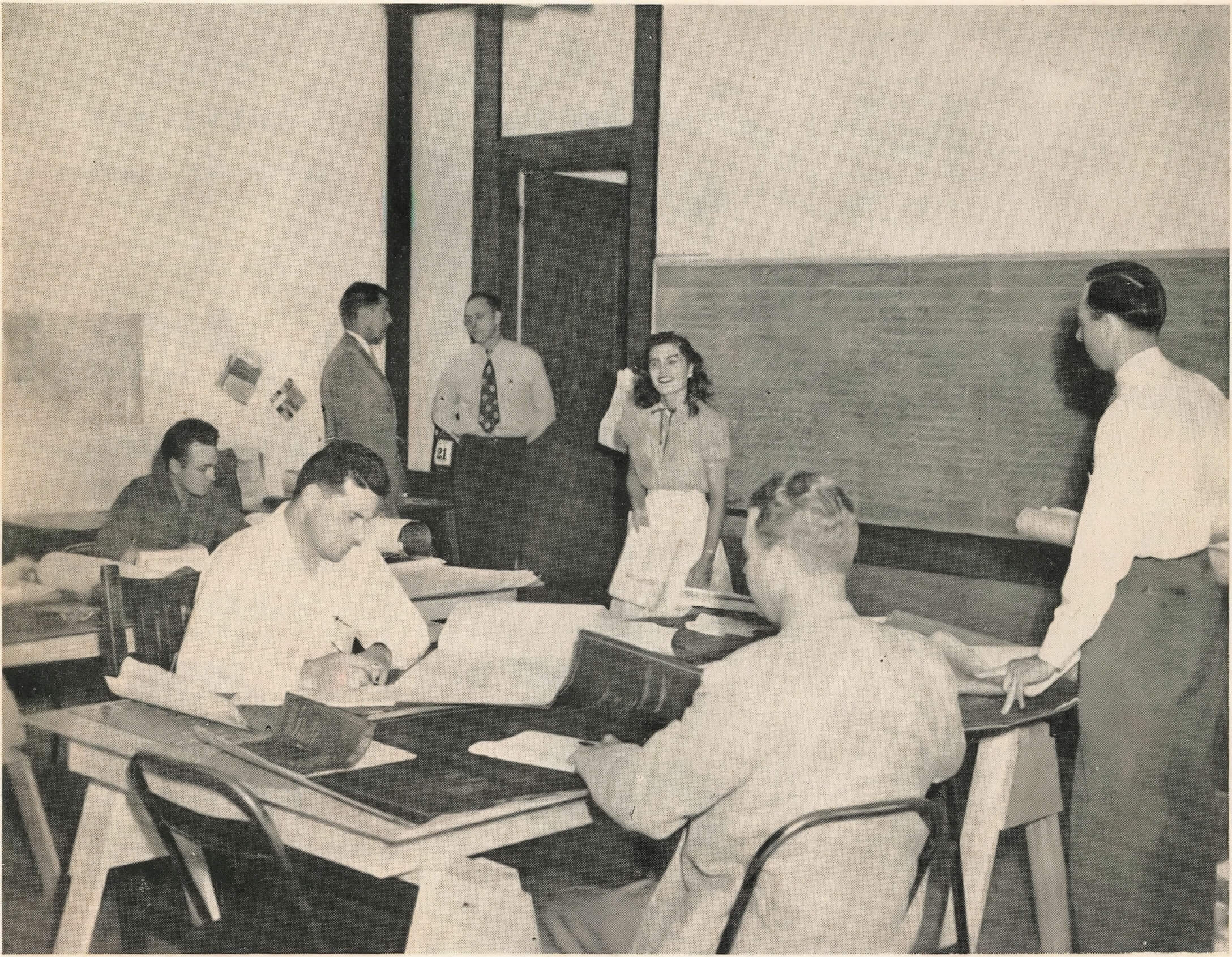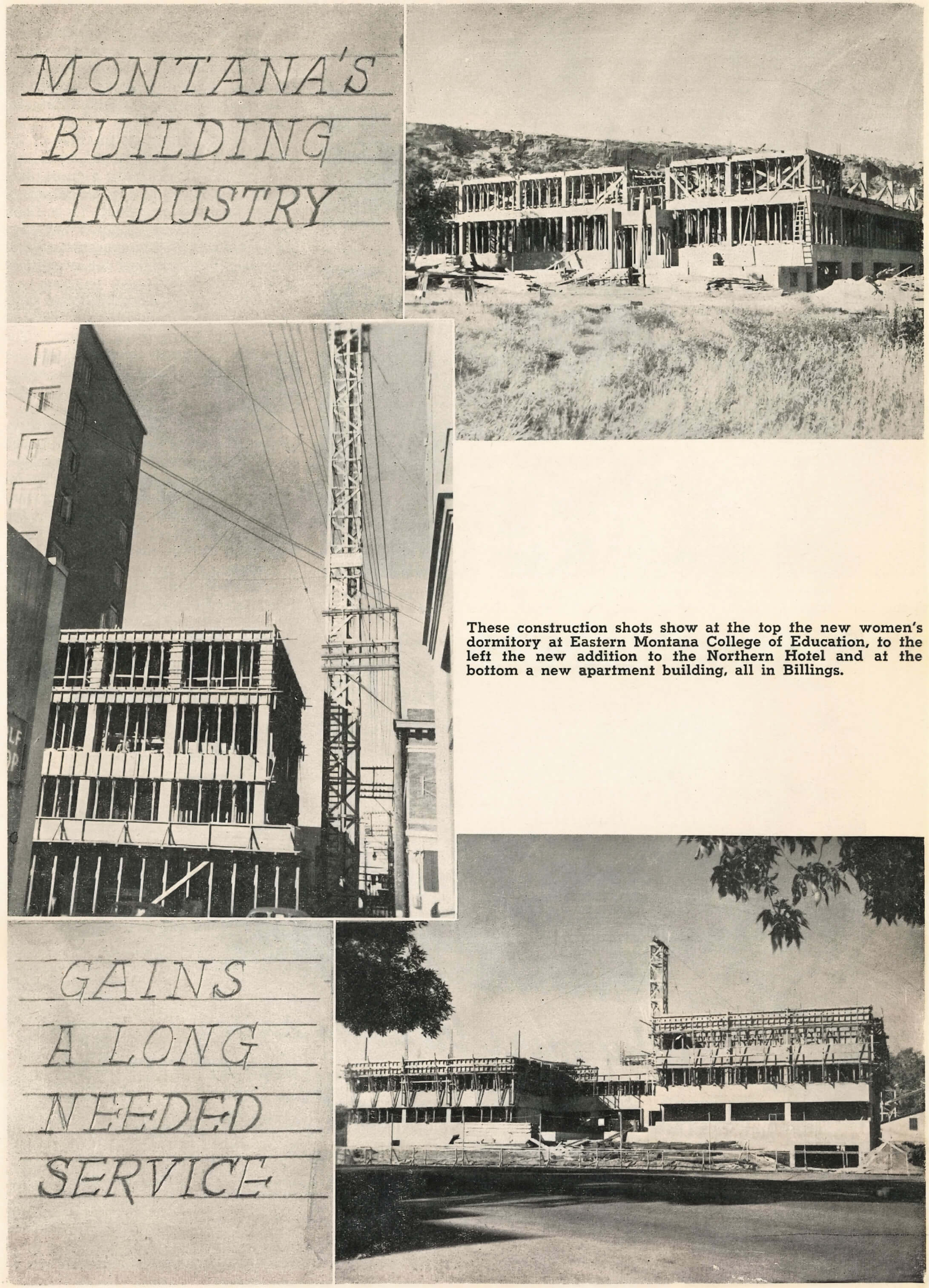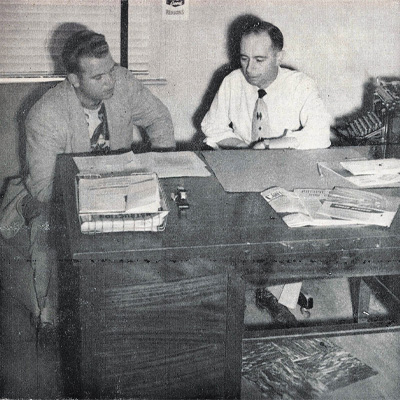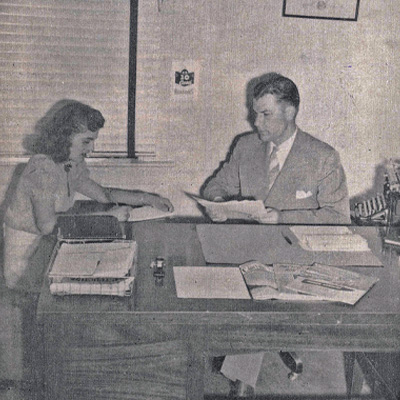Montana's building industry gained a long-needed service last spring with the establishment of the Billings Builders Exchange, a group designed to coordinate all types of building activities between material suppliers, building specialties people, contractors and architects.
The Exchange provides its chief service by making available to the industry plans and specifications on all construction along with up-to-the-minute reports on contemplated construction work and bids that are coming up.

The success of the project was based on the fact that membership in the group is open to all firms and individuals in the building industry including contractors, architects, wholesalers, retail outlets and manufacturer's representatives and supply dealers.
The Billings Builders Exchange provides a service to the architects by setting up a central clearing house where plans for projects may be filed to be available to prospective bidders and suppliers. The owners and persons having the building done are benefited by being referred to firms trained to carry out the work. Manufacturers and their representatives are helped by having available lists of contractors and builders who will be needing their products. Through this greater interchange of information, it is possible for the builder to make greater savings.

The Exchange also assembles information concerning prospective projects in the building industry which are being planned and publishes periodic reports indicating when they will be ready for construction, the place and the owners planning the work. This information is furnished on call to persons or firms interested in the particulars of a project. It also makes available a list of general contractors estimating projects for the use of sub-contractors and suppliers. The Exchange has also been of service to new firms and persons entering Montana and Wyoming by acquainting them with the "who and where" of the building industry.
One of the important features of the Exchange is its "plan room" where interested persons can have a quiet place to study the plans and specifications of various projects in which their firms might be interested. A check-out service for plans is also in operation so that they may be taken out for over-night or week-end study.

The Billings Builders Exchange came into being as a result of the work of the Billings Contractors' Council. The need for a central clearing house for the building industry as well as an agency' to spread information was well recognized by the Council.

Because of the nature of competitive bidding for work in the industry, such an exchange could prove invaluable. Architects having completed plans for a prospective builder advertise for contractors to submit a proposal or bid stating the sum of money for which they will furnish materials and labor to complete the project. This proposal is submitted from estimates prepared based upon the completed plans and written specifications. In preparing bids on construction projects to be submitted to owners, many firms of suppliers, manufacturers' representatives, bonding agencies and subcontractors must consult the plans and specifications covering the work. These agencies whose role in the bidding was minor did not have a set of plans of their own and were using those of the general "prime bidders". Also, information as to time for submitting bids as well as the place and to whom was at best passed along by word of mouth. It was felt a clearing house open to all persons in the industry would be of immense value because it would assemble contractors, suppliers, bonding agencies and manufacturers interested in bidding and provide a central place for them to work. Through architects filing plans with the Exchange more firms would have an opportunity to place a competitive price upon the portion of the work they were in a position to perform or the materials they could manufacture and furnish. Through this process more persons are given a chance to bid and a saving to the owner may be effected. In order for the Exchange to be successful the Council made certain that it should be operated in such a way that it would in no manner limit its membership and would be open to anyone seeking information or wishing to join.
First Year by the Numbers
Total Construction Value
Total Projects
Members
Annual Membership Dues
Montana Projects
Wyoming Projects
North Dakota Projects
"The Exchange is now also financially self-supporting and returning the funds advanced by the Billings Contractors' Council."
Enough money was set aside by the Council to ensure a start for the Exchange and a committee from the Council was appointed with Bud Linville as chairman and Clark Israel, Pete Dahl and Adam Hitz as members. The first job of the committee was to arrange for offices and to consider the hiring of a full-time secretary-manager. Through the cooperation of the Billings Commercial Club, offices were obtained for the Exchange on the third floor of the Commercial Club building. When the Exchange had grown enough so it was able to elect its own officers and board of directors as well as stand on its own feet financially, the duties of the committee were ended.
A great deal of essential planning and gathering of information can be credited to Les G. Hardy of the Cahill- Mooney Construction company. While president of the Billings Contractors Council, Mr. Hardy sent inquiries to firms throughout Montana and Wyoming to get their opinions on the formation of the Exchange as well as their pledge of support. He also approached the American Institute of Architects to obtain their support so that they would send plans to the Exchange for use by its members. Orr Pickering, Billings architect and then president of the AIA, presented the plan to the group and wrote to various members requesting that they support it.

When the money for the project was available the problem of personnel to operate the Exchange was considered. The Contractors' Council was in need of a secretary to care for its needs but could not use a man full time. Therefore, the position of secretary-manager for the Exchange and executive secretary for the Council were combined. Chosen for this job was William J. Bowman, who holds a degree in civil engineering from the University of Minnesota and who had been employed in the Billings city engineer's office and also with the architectural firm of Chandler Cohagen. Mr. Bowman started first as secretary for the Council on January 7, 1950, and during the latter part of January he began to assemble information for the formation of the Exchange.
During the first week in February the formal announcement of the opening of the Exchange was made to the public so that all persons interested might have an opportunity to join and take advantage of the services offered. The response was more than gratifying to the Exchange's originators as firms came forward to give their support immediately.
Now that the foundation work had been completed on March 28, a general membership meeting of all members of the organization was called for the purpose of electing officers, a board of directors and the adoption of articles and by-laws. At this meeting the affairs were turned over from the committee of the Council to the newly elected officers and directors who were DeWayne Linville, president; William Kennedy, vice president; Ralph Woodley, treasurer, and Adam Hitz, T. 0. Rickman, Lee Anderson, Orr’ Pickering and George Pelatt, directors.
One of the first objectives was the publication of a weekly bulletin and the first of these was placed in the hands of the members and interested persons on March 22. At the present time the circulation covers firms over the states of Montana and Wyoming as well as architects and engineers throughout that area. From its beginning of one mimeographed sheet, it has grown to its present size of a cover sheet and a body of five to seven sheets and is one of the most vital activities carried on by the Billings Builders' Exchange.
The first Exchange in Montana was now underway and heading for success. During its first nine months the exchange handled construction business amounting to $20,000,000. It handled 121 plans, 37 of which were constructed in Wyoming and three in North Dakota. These included schools, churches, hospitals, clinics, office buildings, homes as well as shops and government projects
The Exchange is now also financially self-supporting and returning the funds advanced by the Billings Contractors' Council.
A non-profit organization, the group now has 125 members with some firms located from Illinois to Spokane, Washington, with the majority, however, in Montana and Wyoming.

The organization held its first annual meeting in December at which they elected new officers. William M. Kennedy, former vice-president, succeeded DeWayne Linville as the new head of the group. Other officers elected were: P. C. Dahl, vice-president, and Ralph Woodley, re-elected treasurer. George Frisby was elected to succeed Lee Anderson as one-year director. Adam Hitz and Orr Pickering are holdover directors for three years and T. 0. Rickman and George Pelatt for two years.
Although the war situation has limited private construction, the Exchange is going out after defense plant work. So whatever the situation the Billings Builders' Exchange is on the job helping to build Montana.